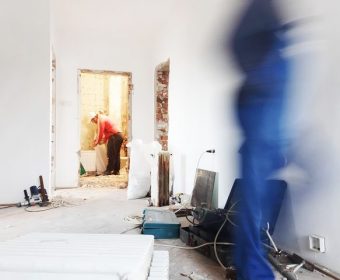
Asbestos exposure usually happens in the workplace and can lead to pleural mesothelioma, an aggressive lung cancer. However, asbestos exposure also can occur during home renovations, which also can cause mesothelioma.
Builders constructed hundreds of thousands of homes in the US before the EPA put restrictions on asbestos-containing insulation. Disturbing this insulation during home renovations can cause a dangerous release of asbestos fibers in the air.
Asbestos Diseases and Home Renovations
When asbestos fibers are inhaled or swallowed, they can get stuck in the lungs or abdominal lining. Over the years, the asbestos particles can cause scarring and DNA changes that can make tumors grow. Asbestos exposure from home renovations also can cause asbestosis and pleural effusions.
Inhaling asbestos is the top cause of mesothelioma, which often is not diagnosed until the later stages. Most people with mesothelioma live for less than a year.
Home renovations often cause asbestos exposure; an Australian study determined that 60% of DIY home renovators suffered asbestos exposure. Approximately 50% said their spouse or partner was exposed, and 40% said their children might have been exposed to asbestos, as well.
Asbestos Restrictions in Homes
Asbestos was used to build homes for decades in the United States. It was popular because it is highly heat and fire-resistant. However, scientists discovered that the tiny asbestos fibers could lodge in the organs and cause cancer. At that time, the EPA put restrictions on using asbestos in homes. But the dangerous mineral still is not banned in the US.
The EPA initially put restrictions on some asbestos-containing materials in the early 1970s. These hazardous materials were almost totally banned by 1990. However, the federal courts overturned that ban in 1991. Today, the United States is one of the few advanced nations that has not 100% banned asbestos. It is still used in some home building products, but asbestos must be contained, so it does not enter the air.
Homebuilding Products Containing Asbestos
The EPA states that flooring felt, commercial and specialty paper, rollboard, and corrugated paper cannot contain asbestos. Some forms of spray-applied surfacing products and pipe insulation also are outlawed. Wall patching products and artificial fireplace embers also are banned. Further, any new products that did not have asbestos in the past also cannot contain the carcinogen.
Because of the overturn of the 1990 EPA ban, there are still building materials and related products that contain asbestos. Some of these products include:
- Vinyl floor tiles
- Cement flat sheet
- Corrugated sheet
- Roof coatings
- Roofing felt
- Cement pipe
- Cement shingle
- Millboard
- Pipeline wrap
- Non-roofing coating products
Watch For Asbestos During Home Renovations
Modern houses in the United States may contain asbestos because of the overturned 1990 ban. Note that homes built before 1985 are more likely to contain asbestos. Any renovation project involving a house built before the mid-1980s should include steps to contain or remove the asbestos if it is discovered.
If you think the home contains asbestos, contact a licensed asbestos abatement professional for assistance. It is dangerous to remove asbestos-containing materials without the proper protective gear. The materials also must be disposed of in a way that will not endanger people or the environment.
Because of the risks related to asbestos exposure, it is critical to understand where the carcinogen may be in your house. Asbestos is often enclosed so that the fibers cannot go airborne and expose people. But if you break into walls, take out pipes and plumbing fixtures, or do other renovations, you could disturb asbestos fibers. If so, you will contaminate the air in the house and endanger yourself and others.
Some areas more likely to contain asbestos are:
- Older linoleum and vinyl tiles and the glue that adhered them to the floor
- Flat roofing products
- The insulation used around HVAC furnaces, ducts, and pipes
- Outdoor siding
- Glazing and caulking for windows
- Decorative plaster
- Joint compound and drywall patching
If you remove something from the home during renovations that is a white, fibrous material that breaks apart, it could be asbestos. It is impossible to tell for sure unless you have an asbestos abatement professional look at the material. Asbestos abatement workers can contain the carcinogen or remove it, but never attempt to do it yourself.
What Is Asbestos Abatement?
Professionals must perform the identification, containment, and removal of asbestos. Asbestos exposure risks are too significant to try to remove the substance without professional help. Licensed asbestos abatement companies can check the property for asbestos and remove it safely.
As you plan to renovate your home, the best way to prevent asbestos exposure is to contact a professional before starting your project. It is wise to find asbestos in the property before you begin to avoid health hazards. Taking these critical steps could save you danger and expense later.
Summary
Remember, it can take decades for mesothelioma symptoms to appear. Your home renovation may have exposed you to asbestos and caused your disease. If you are diagnosed with mesothelioma after improper asbestos removal or a previous owner’s failure to tell you about asbestos in the home, you may be eligible for compensation in a mesothelioma lawsuit.
References
- The Problem of Asbestos in Home Remodels. Accessed at https://www.deseretnews.com/article/865568499/The-problem-of-asbestos-in-home-remodels.html
- This House Killed Me: DIY Home Renovators The Third Wave of Asbestos Victims. Accessed at https://www.smh.com.au/national/nsw/this-house-killed-me-diy-home-renovators-the-third-wave-of-asbestos-victims-20170531-gwh2x1.html.
- Are You Getting Ready to Do Some Home Renovations? Accessed at https://www.flagstaff.az.gov/DocumentCenter/View/6864/home-owner-asbestos-website-info?bidId=



